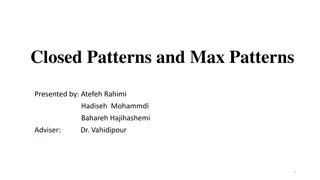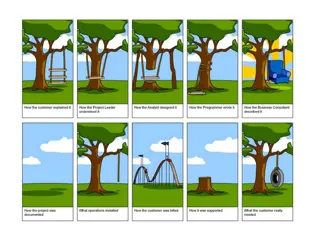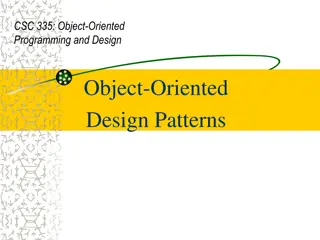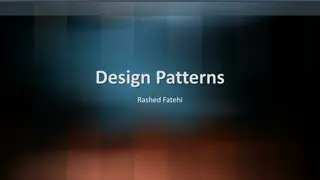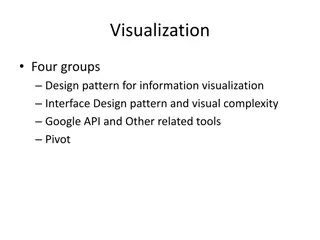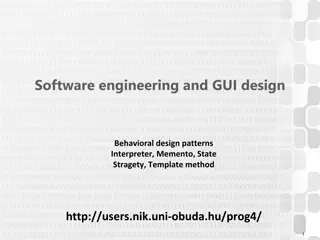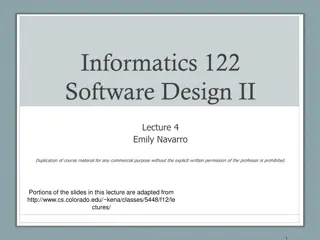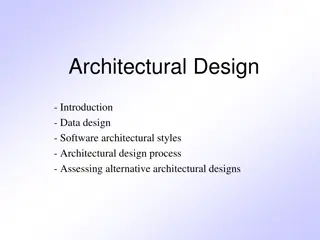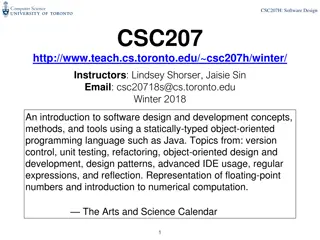Understanding Software Design Principles and Patterns
Delve into the world of software engineering and architecture through the lens of compositional design principles and the renowned Gang of Four (GoF) design patterns. Explore how design patterns solve complex problems and learn about the significance of programming to an interface rather than an implementation. Gain insights into practical examples highlighting the importance of collaboration, flexibility, and abstraction in software development.
Download Presentation

Please find below an Image/Link to download the presentation.
The content on the website is provided AS IS for your information and personal use only. It may not be sold, licensed, or shared on other websites without obtaining consent from the author. Download presentation by click this link. If you encounter any issues during the download, it is possible that the publisher has removed the file from their server.
E N D
Presentation Transcript
Software Engineering and Architecture Compositional Design Principles
Gang of Four (GoF) Erich Gamma, Richard Helm Ralph Johnson & John Vlissides Design Patterns Elements of Reusable Object-Oriented Software Addison-Wesley, 1995. (As CD, 1998) First systematic software pattern description. CS@AU Henrik B rbak Christensen 2
The most important chapter Section 1.6 of GoF has a section called: How design patterns solve design problems This section is the gold nugget section It ties the patterns to the underlying coding principles that delivers the real power. CS@AU Henrik B rbak Christensen 3
Compositional Design Principles CS@AU Henrik B rbak Christensen 4
As the 3-1-2 process CS@AU Henrik B rbak Christensen 5
First Principle CS@AU Henrik B rbak Christensen 6
GoFs 1st principle Program to an interface, not an implementation In other words Assume only the role (the responsibilities + protocol) and never allow yourself to be coupled to implementation details and concrete behavior CS@AU Henrik B rbak Christensen 7
First Principle Program to an interface because You only collaborate with the role not an individual object You are free to use any service provider class! Any class that implements that interface You do not delimit other developers for providing their service provider class! You avoid binding others to a particular inheritance hierarchy Which you would do if you use (abstract) classes CS@AU Henrik B rbak Christensen 8
Example Early pay station GUI used JLabel for visual output I only use method: setText() CS@AU Henrik B rbak Christensen 9
Example The I found SoftCollection s number display, got permission to use it, but... ... And use: CS@AU Henrik B rbak Christensen 10
Morale It would have been easy to make the code completely identical, and thus support full reuse, in which I simply configure PayStationGUI with the proper text panel to use. But I cannot! Because LCDDigitDisplay does not inherit JLabel!!! Thus instead of dependency injection and change by addition I get Change by modification I have to start my editor just to change one declaration! I can never get a framework out of this! CS@AU Henrik B rbak Christensen 11
Could have been solved If JLabel was an interface instead! Interface IJLabel setText(String s); LCDDigitDisplay GUI IJLabel JLabel Then there would be no hard coupling to a specific inheritance hierarchy. MyLCDDigitDisplay CS@AU Henrik B rbak Christensen 12
Interfaces allow fine-grained behavioral abstractions Clients can be very specific about the exact responsibility it requires from its service provider Role interfaces SOLID : I = Interface Segregation Example: Collections.sort(List<T> list) can sort a list of objects of any type, T, if each object implements the interface Comparable<? super T> i.e. must implement method int compareTo(T o) . Low coupling no irrelevant method dependency! CS@AU Henrik B rbak Christensen 13
Interfaces better express roles Interfaces express specific responsibilities whereas classes express concepts. Concepts usually include more responsibilities and they become broader! Small, very well defined, roles are easier to reuse as you do not get all the stuff you do not need... CS@AU Henrik B rbak Christensen 14
Second Principle CS@AU Henrik B rbak Christensen 15
GoFs 2nd principle Favor object composition over class inheritance What this statement says is that there are basically two ways to reuse code in OO! And the compositional one should be favored! CS@AU Henrik B rbak Christensen 16
Benefits of class inheritance Class inheritance You get the whole packet and tweak a bit by overriding a single or few methods Fast and easy (very little typing!) Explicit in the code, supported by language (you can directly write extends ) But... CS@AU Henrik B rbak Christensen 17
Encapsulation inheritance breaks encapsulation Snyder (1986) CS@AU Henrik B rbak Christensen 18
Why? No encapsulation because Subclass can access every instance variable/property data structure Method of any superclass (except those declared private) Thus a subclass and superclass are tightly coupled You cannot change the root class data structure without refactoring every subclass in the complete hierarchy CS@AU Henrik B rbak Christensen 19
Only add responsibilities, never remove You buy the full package! All methods, all data structures Even those that are irrelevant or down right wrong! CS@AU Henrik B rbak Christensen 20
Example Vector<E> void add(int index, E element) (= an ArrayList almost ) Stack<E> extends Vector<E> E pop() void push(E item) Argue why this is a design with many liabilities? How can you rewrite it elegantly using composition? Henrik B rbak Christensen CS@AU 21
Rewriting to Composition Class Stack has-a Vector , instead of Stack is-a Vector Much better design! Stack does not have any Vector/List methods, only push() and pop() CS@AU Henrik B rbak Christensen 22
Compile time binding The only way to change behavior in the future (tweak a bit more) is through the edit-compile-debug-debug- debug-debug cycle Any implementing class of List<String> can be substituted here (by Dependency Injection), thus no hard coupling between Stack and Vector CS@AU Henrik B rbak Christensen 23
Recurring modifications Constantly bubbling of behavior up into the root class in a hierarchy Review the analysis in the State pattern chapter Another example Nice service based upon ArrayList Now want better performance in new variant All three classes modified CS@AU Henrik B rbak Christensen 24
Separate Testing Often, small and well focused abstractions are easier to test than large classes a) Only integration testing possible (NewS. + ExistS.) b) Allows unit testingof ExistingService1+2 , and often unit testing of NewService, by replacing collaborators with Test Stubs ala StubService1 and StubService2 CS@AU Henrik B rbak Christensen 25
Increase possibility of reuse Smaller implementations are easier to reuse Example from MiniDraw Sub responsibility Allow compositional reuse of FigureCollection in all present and future impl. of Drawing! CS@AU Henrik B rbak Christensen 26
Liabilities Increased number of abstractions and objects Delegation requires more boiler-plate code CS@AU Henrik B rbak Christensen 27
(what is he saying???) Inheritance is an interesting construct, but It often leads to lesser designs It does not elegantly handle ad hoc reuse modelling roles variance of behavior CS@AU Henrik B rbak Christensen 28
When to use Inheritance? My rule of thumb Iff there is behavioral differences between subclasses Not just parameters and constants; it must be different algorithms Iff you are absolutely sure there will be only one dimension of variability and a shallow inheritance tree Often I later find I can rewrite it E2023 E2024 Gfx rendering difference is just a set of parameters See slides in Week 9 CS@AU Henrik B rbak Christensen 29
Third Principle CS@AU Henrik B rbak Christensen 30
GoFs 3rd principle Consider what should be variable in your design [GoF 1.8, p.29] Another way of expressing the 3rd principle: Encapsulate the behavior that varies CS@AU Henrik B rbak Christensen 31
Analysis This statement is closely linked to the shorter Change by addition, not by modification That is you identify the design/code that should remain stable the design/code that may vary and use techniques that ensure that the stable part well remain stable These techniques are 1st and 2nd principle most of the time CS@AU Henrik B rbak Christensen 32
The Principles In Action CS@AU Henrik B rbak Christensen 33
Principles in action Applying the principles lead to basically the same structure of most patterns: New requirement to our client code Client CS@AU Henrik B rbak Christensen 34
Principles in action Applying the principles lead to basically the same structure of most patterns: Consider what should be variable Client Variability CS@AU Henrik B rbak Christensen 35
Principles in action Applying the principles lead to basically the same structure of most patterns: Program to an interface interface Variability Client CS@AU Henrik B rbak Christensen 36
Principles in action Applying the principles lead to basically the same structure of most patterns: Favor object composition interface Variability Client ConcreteVariation1 ConcreteVariation2 CS@AU Henrik B rbak Christensen 37
And that is why most patterns follows this structure exactly They encapsulate variability and favor composition interface Variability Client ConcreteVariation1 ConcreteVariation2 CS@AU Henrik B rbak Christensen 38
Summary We identified some behaviour that was likely to change Consider what should be variable in your design We stated a well defined responsibility that covers this behaviour and expressed it in an interface Program to an interface, not an implementation Favor object composition over class inheritance Instead of performing behaviour ourselves we delegated to an object implementing the interface CS@AU Henrik B rbak Christensen 39
SOLID A more well known set of principles than more or less the same , but states CS@AU Henrik B rbak Christensen 40
SOLID is Solid An architectural style for large systems: Microservices Key architecture for Uber, Google, NetFlix, Lots of tooling, lots of architectural tactics, lots of design doctrines to follow, but Uber Data At the core, it is.. Design with high cohesion and low coupling Design according to SOLID Program to an interface, favor object composition CS@AU Henrik B rbak Christensen 41






